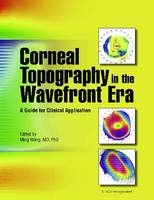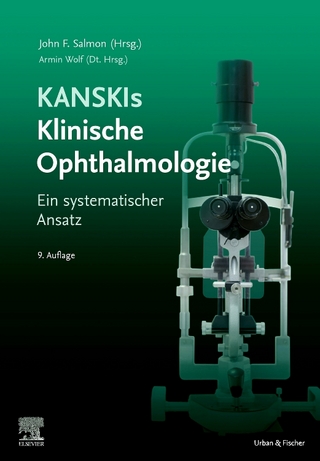
Corneal Topography in the Wavefront Era
SLACK Incorporated (Verlag)
978-1-55642-718-3 (ISBN)
- Titel ist leider vergriffen;
keine Neuauflage - Artikel merken
Understanding corneal topography is essential for an anterior segment surgeon, general ophthalmologist and optometrist. "Corneal Topography" delivers the information needed to develop an understanding of the state-of-the-art corneal topographic technology and its relationship to keratorefractive surgery. As the popularity of wavefront sensing continues to rise, it is important to keep pace with the latest developments in corneal topography, which remains an indispensable part of anterior segment ophthalmology practice. The improvement in corneal topographic and wavefront-sensing technologies coupled with the advent of an innovative custom treatment approach using these two technologies has ushered in a new era of cornea and refractive surgery with unprecendented superior clinical outcomes. In response to the need for an updated corneal topography reference, Dr. Ming Wang organized a team of over 30 of the field's leading professionals to produce this informative and comprehensive text. Inside "Corneal Topography", you will find a comprehensive review of the science of corneal topography and principles and application of all major topographic imaging systems currently available.
Emphasis is placed on clinical use of these topographic systems in addition to pre- and postoperative evaluation and management of refractive surgery patients. New technologies such as topography-guided and combined wavefront and topography-guided custom treatments are presented. The clinical case presentations reinforce the key scientific concepts discussed early in the text as well as serve as a rapid and easy-access reference for the most common examples of topographic problems found in anterior segment and refractive surgery patients. Color figures and topographical maps are extensively used to illustrate the types and features of corneal topography and clinical case presentation. In today's wavefront era, it is important to understand the role of corneal topography in the anterior segment and refractive surgery practice. "Corneal Topography"'s focus and scope makes it a must-have reference for all ophthalmologists and optometrists.
Topics Include: Anatomy and physiology of the cornea; Classification of topographic technologies; Scales and conventions used in corneal topography; Principles and applications of major types of corneal topographies; Clinical case presentation of commonly encountered problems in anterior segment and refractive surgery; Posterior corneal changes in refractive surgery; New technology in corneal topography - driven treatment; New technologies in combined custom treatment approach using corneal topography and wavefront sensing.
Ming Wang, MD, PhD, is a Clinical Associate Professor of Ophthalmology at the University of Tennessee, Attending Surgeon at Saint Thomas Hospital, and Director of Wang Vision Institute in Nashville, Tennessee, USA. He is also the Director of Refractive Surgery at the Aier Eye Hospitals, the largest private eye hospital system in China. Dr. Wang received his doctorate degree in laser spectroscopy and his post-doctorate fellowship from the University of Maryland in College Park, Maryland, and the Massachusetts Institute of Technology in Boston, Massachusetts, respectively. In 1991, he received his medical degree (graduating magna cum laude and receiving the award for the best thesis) from Harvard Medical School and Massachusetts Institute of Technology in Boston, Massachusetts, and the Harold Lamport Biomedical Research Prize from Harvard and MIT. After completing both a residency in ophthalmology and a fellowship in ocular genetics at the Wills Eye Hospital in Philadelphia, Pennsylvania, he completed a clinical fellowship in cornea and external disease and refractive surgery at the Bascom Palmer Eye Institute, University of Miami School of Medicine in Miami, Florida. In 1997, he became the founding director of the Vanderbilt Laser Sight Center and a full-time faculty member of the Department of Ophthalmology at the Vanderbilt University School of Medicine. He remained at Vanderbilt for 5 years before he went into private practice in 2002. www.wangvisioninstitute.com Dr. Wang's research career encompasses three distinctively different fields. From 1982 to 1987, he published as the first author of a dozen original papers in the leading physics journal, Physical Review A, describing the development of a novel experimental atomic physics technique that he developed with Professor John Weiner, a Doppler velocity-selected associative ionization process between sodium atoms. In 1987, Dr. Wang turned his inquisitive mind to the study of molecular biology at Harvard and MIT, and published as the first author of a major paper in the world-renowned journal, Nature, regarding a novel molecular biology technique that he invented with Professor George Church, a whole-genome approach to in vivo DNA-protein interaction and gene expression regulation. After research careers in experimental atomic physics and molecular biology, Dr. Wang then began yet another research career in 1992, this time in ophthalmology, ocular genetics, novel anterior segment reconstructive surgeries, and corneal topography. Working with Professor Larry Donoso, he cloned the first ocular melanoma-associated antigen. Dr. Wang made an original contribution to the field of corneal wound healing by publishing with Professor Scheffer Tseng the first paper in the literature regarding laboratory success in the reduction of corneal scarring and apoptosis with amniotic membrane transplantation. Dr. Wang holds a U.S. patent for his invention of the amniotic membrane contact lens, and he successfully made the first prototype. He was a former consultant to the U.S. Food and Drug Administration Ophthalmic Device Panel and a primary reviewer for the panel for the first U.S. LASIK approval by the FDA in 1999. Dr. Wang conducted the first large-scale clinical study and was the principal clinical investigator of the first 3-D stereo corneal topographer, AstraMax. He was the first surgeon from the U.S. to study a new, high frequency excimer laser and treatment-planning platform designed to treat post-LASIK complex eyes. Dr. Wang performed the first femtosecond laser-assisted artificial cornea implantation. He was a LASIK surgeon for ABC's national network reality show program, Extreme Makeover. Dr. Wang is on the editorial board of Cataract and Refractive Surgery Today, and is a reviewer for Ophthalmology, American Journal of Ophthalmology, Cornea, Journal of Cataract and Refractive Surgery, Journal of Refractive Surgery, Genome, and Investigative Ophthalmology and Visual Sciences. Dr. Wang was the editor of Corneal Dystrophies and Degenerations, published by the American Academy of Ophthalmology. He offers the only fellowship in cornea and external disease and refractive surgery in the state of Tennessee. He has been invited to lecture around the world and is an honorary professor of ophthalmology at Xiamen and Zhongshan Medical Universities in China and Shanghai Aier Eye Hospital, where in 2005 he performed China's first Intralase LASIK procedure. Dr. Wang is the founding chairman of the Wang Foundation for Sight Restoration, a nonprofit organization that assists terminally corneal blind patients to undergo novel eye reconstructive surgeries performed free of charge by Dr. Wang. The foundation holds an annual fundraiser, the Eye Ball, each year in the fall. Dr. Wang is the recipient of numerous awards, including being listed continuously each year by Castle Connelly as one of the Best Doctors in America (an honor bestowed on less than 1 percent of U.S. physicians), a Fight for Sight Research Grant of the Research Division to Prevent Blindness, faculty research award of Vanderbilt University, and was a co-principal investigator of a RO1 grant from the National Institutes of Health. Dr. Wang has a diverse interest in hobbies. He has a band with classical guitarist Mr. Carlos Gonzalez called Music for Sight, in which Dr. Wang plays the Er-hu, a Chinese violin. In Dolly Parton's new CD, Those Were the Days, he played his Er-hu to Ms. Parton's song "The Cruel War." In addition, Dr. Wang is an accomplished ballroom dancer and member of the U.S. collegiate champion Harvard University team. He is the president of the Music City Chapter of the United States Amateur Ballroom Dancers Association, and is ranked fourth in the United States in pro-am international ballroom 10-dance.
| Erscheint lt. Verlag | 30.7.2006 |
|---|---|
| Zusatzinfo | Illustrations (chiefly col.) |
| Sprache | englisch |
| Themenwelt | Medizin / Pharmazie ► Medizinische Fachgebiete ► Augenheilkunde |
| Medizin / Pharmazie ► Medizinische Fachgebiete ► Chirurgie | |
| ISBN-10 | 1-55642-718-2 / 1556427182 |
| ISBN-13 | 978-1-55642-718-3 / 9781556427183 |
| Zustand | Neuware |
| Haben Sie eine Frage zum Produkt? |
aus dem Bereich


